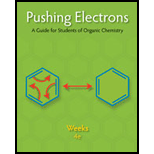
Concept explainers
One Lewis structure for the 2-butenyl cation is

Interpretation:
The resonance structure of the given molecule is to be determined
Concept Introduction:
When the electron distribution of a molecule can be depicted correctly in more than one way using different Lewis structures, the drawings are called resonance structures.
Resonance structures have no discrete existence of their own but, taken in combination, describe the true structure of the molecule.
Answer to Problem 1EQ
The resonance structure of the given molecule is,

Explanation of Solution
Lewis structure for 2-butenyl cation:

A new resonance structure can be shown as,

The arrow mark represents the shift of pi-electrons.
The resonance structure of the given molecule is drawn.
Want to see more full solutions like this?
Chapter 2 Solutions
Pushing Electrons
- Consider the pyrosulfate ion, S2O72-. It has no sulfur–sulfur nor oxygen–oxygen bonds. (a) Write a Lewis structure for the pyrosulfate ion using only single bonds. (b) What is the formal charge on the sulfur atoms for the Lewis structure you drew in part (a)? (c) Write another Lewis structure using six bonds and two O—S bonds. (d) What is the formal charge on each atom for the structure you drew in part (c)?arrow_forwardWrite all resonance structures of chlorobenzene, C6H5Cl, a molecule with the same cyclic structure as benzene. In all structures, keep the CCl bond as a single bond. Which resonance structures are the most important?arrow_forwardAn carbon-to-oxygen single bond (i.e. C-O) has a bond energy of 358 kJ/mol and an carbon-to-oxygen double bond (i.e. C=O) has a bond energy of 749 kJ/mol. Estimate the value of the carbon-to-oxygen bond energy in the carbonate anion, CO32— . Hint: draw the Lewis structure of CO32— , consider resonance and determine which type of bonds it has. Because of the resonance, the bond between C and O will be somewhere in between the single and double bond. Group of answer choices 1107 kJ/mol 358 kJ/mol 488 kJ/mol 928 kJ/mol 1465 kJ/mol 618 kJ/mol 749 kJ/mol 554 kJ/molarrow_forward
- Sulfuric acid is the industrial chemical produced in greatest quantity worldwide. About 90 billion pounds are produced each year in the United States alone. Write the Lewis structure for sulfuric acid, H2SO4, which has twooxygen atoms and two OH groups bonded to the sulfur.arrow_forwardMany free radicals combine to form molecules that do not contain any unpaired electrons. The driving force for the radical- radical combination reaction is the formation of a new electron-pair bond. Consider the formation of hydrogen peroxide. 2 OH(g) → H₂O₂(g) Write Lewis formulas for the reactant and product species in the chemical equation. Include nonbonding electrons. OH(g) Select Draw Rings More / ||| ||| Erase Q2 Q H₂O₂(g) Select Draw Rings More 3 S H Erase Q2 Q Question Source: McQuarrie, Rock, And Gallogly 4e - General Chemistry Publisher: University Science Barrow_forwardChloral, Cl3C—CH=O, reacts with water to form the sedative and hypnotic agent chloral hydrate, Cl3C—CH(OH)2. Draw Lewis structures for these substances, and describe the change in molecular shape, if any, that occurs around each of the carbon atoms during the reaction.arrow_forward
- Based on average bond enthalpies, would you expect a photon capable ofdissociating a C¬Cl bond to have sufficient energy to dissociate a C¬Br bond?arrow_forwardAlthough carbon has four bonds in stable molecules, sometimes reactive carbon intermediates that contain carbon atoms without four bonds are formed for very short time periods. Examples of these unstable intermediates include the methyl carbocation (CH 3) + and the methyl carbanion (CH 3) −. Draw Lewis structures for both unstable ions and predict the shape around carbon.arrow_forwardWrite the Lewis structure for the NH4 + ion.arrow_forward
- Hydrazine, N2H4, burns in oxygen as follows: N2H4 + O2 → N2 + 2H2O [The bond energies in kJ/mol are: N-H = 388; N-N 163; N≡N 944; O-H 463; O=O 496] Draw the chemical structures of the reactants and products and give the formula to calculate enthalpy change in a reaction, ΔH.arrow_forwardWrite a Lewis structure for the amide ion, NH2─, and assign formal charges to each atom.arrow_forwardDraw a Lewis structure for the azide ion, N3-. (The order of atom attachment is N-N-N, and they do not form a ring.) How does the resonance model account for the fact that the lengths of the N-N bonds in this ion are identical?arrow_forward
 Chemistry: Principles and PracticeChemistryISBN:9780534420123Author:Daniel L. Reger, Scott R. Goode, David W. Ball, Edward MercerPublisher:Cengage Learning
Chemistry: Principles and PracticeChemistryISBN:9780534420123Author:Daniel L. Reger, Scott R. Goode, David W. Ball, Edward MercerPublisher:Cengage Learning Chemistry: Principles and ReactionsChemistryISBN:9781305079373Author:William L. Masterton, Cecile N. HurleyPublisher:Cengage Learning
Chemistry: Principles and ReactionsChemistryISBN:9781305079373Author:William L. Masterton, Cecile N. HurleyPublisher:Cengage Learning Chemistry: The Molecular ScienceChemistryISBN:9781285199047Author:John W. Moore, Conrad L. StanitskiPublisher:Cengage Learning
Chemistry: The Molecular ScienceChemistryISBN:9781285199047Author:John W. Moore, Conrad L. StanitskiPublisher:Cengage Learning


